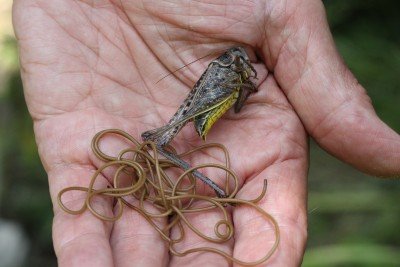
So, what exactly are wolf worms? Let’s dive in and explore how they affect small mammals in the wild. We’ll cover their life cycle, impact on hosts, and what this all means for the ecosystem. Grab a cup of coffee, and let’s unravel this fascinating topic.
What Are Wolf Worms?
Wolf worms, also known as larvae of the botfly, are a type of parasitic fly that often targets small mammals like rodents and rabbits. These worms don’t just pop up randomly; they have a unique life cycle that begins with an adult botfly laying its eggs on a host animal. When the eggs hatch, the larvae burrow into the host’s skin, feeding and growing within the tissues. It might sound a bit like a horror movie, but this is a natural part of their life.
You might be wondering why they’re called “wolf worms.” The name comes from their association with wolves and other carnivores, although many small mammals can be affected as well. Think of it like a tiny passenger taking a ride in a very uncomfortable taxi cab.
How Do Wolf Worms Infect Small Mammals?
The infection process begins when the adult botfly lays its eggs on a host animal—often during the warmer months when animals are more active. The larvae hatch after a few days, and here’s the kicker: they make their way into the host’s body by burrowing through the skin.
This isn’t just a simple burrowing; it can be a painful experience for the host. Imagine a tiny creature shoving itself into your skin without your permission! Once inside, the larvae feed on the host’s tissues, which can lead to all sorts of complications.
In some cases, the host might not even realize it’s infected right away. Initial symptoms could be mild, but as the larvae grow, they can cause swelling, discomfort, and even secondary infections. That’s why it’s essential for wildlife to be vigilant, and for ecosystem balance to be maintained.
The Impact on Small Mammal Hosts
The presence of wolf worms can significantly impact the health of small mammals. When infected, these animals often experience lethargy, impaired mobility, and reduced feeding behaviors. Imagine puny little rabbits out in the wild, struggling to hop about because they’re too tired or uncomfortable. It can be a sad sight.
As wolf worms feed on the host’s tissue, they can also create open wounds or sores. These can become gateways for other infections, leaving the host even more vulnerable to illness. The struggle for survival becomes even more daunting, especially when food is scarce, or predators are lurking.
Over time, high levels of infection can lead to a decline in the population of affected species. This is particularly concerning for mammals like rabbits and rodents, which play a crucial role in the food chain. Fewer rabbits mean less food for their predators, disrupting the entire ecosystem.
Wolf Worms and Ecosystem Dynamics
Wondering how this all fits into the bigger picture? Wolf worms influence not just the individual mammals they infect but also the broader ecosystem. When small mammals are weakened or die off due to infections, it can trigger a ripple effect throughout the food web.
For instance, predators that rely on these small mammals for food may face starvation, leading to declines in their populations as well. This change can disrupt the balance of the ecosystem, making it essential to monitor and manage the health of these small mammals.
Interestingly, some researchers argue that while wolf worms can be harmful, they also act as a natural population control mechanism. By keeping small mammal populations in check, they help maintain the delicate balance of nature. It’s a tough lesson in survival, but it’s how ecosystems evolve and adapt.
Signs of Wolf Worm Infestation in Small Mammals
Knowing the signs of a wolf worm infestation can be vital for conservationists, wildlife enthusiasts, and anyone interested in the health of small mammals. Here are some common indicators to watch out for:
- Swelling or lumps beneath the skin: These can be signs of larvae developing inside the host.
- Open sores or wounds: If a small mammal has visible wounds, it may be a sign of infection.
- Lethargy and reduced movement: Infected animals may appear sluggish or struggle with normal activities.
- Behavior changes: Look for unusual grooming habits or changes in feeding. An animal might stop eating if it’s in discomfort.
If you notice these signs in wild mammals, it’s crucial to report them to wildlife authorities. Early detection can help manage and mitigate the impact of these parasites.
Managing Wolf Worm Infections
So, what can be done about wolf worms? While there’s no simple cure, management strategies focus on monitoring and preventing outbreaks. Here are some approaches:
1. Wildlife monitoring: Conservationists often keep an eye on populations of small mammals to track health trends.
2. Habitat management: Maintaining healthy ecosystems can support wildlife resilience against parasites by providing adequate food and shelter.
3. Public education: Raising awareness about the signs of wolf worm infestations can help in reporting and managing cases effectively.
Educating the public, particularly in areas populated by small mammals, can lead to early detection and intervention, ultimately saving many lives.
Wolf worms might not be the most glamorous topic in wildlife discussion, but their impact on small mammals is significant. From infection to the potential decline of species, these little parasites remind us of the complexities of nature.
Understanding how wolf worms work helps us appreciate the delicate balance of ecosystems and the importance of maintaining healthy wildlife populations. By sharing this knowledge, we can contribute to conservation efforts and ensure a thriving environment for all creatures, big and small. So next time you hear about wolf worms, remember how they play a role in the wild—sometimes as an uninvited guest, but always part of nature’s intricate dance.
